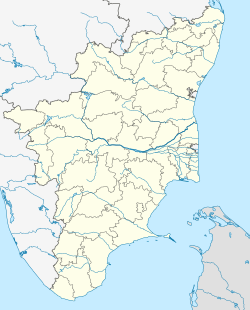Kulasekarapattinam Kulasekharapatnam, Kulasekarapatnam | |
|---|---|
Town | |
| Coordinates: 8°24′0″N78°3′0″E / 8.40000°N 78.05000°E | |
| Country | India |
| State | Tamil Nadu |
| District | Thoothukudi |
| Area | |
• Total | 12.5 km2 (4.8 sq mi) |
| Population (2001) | |
• Total | 12,010 |
| • Density | 961/km2 (2,490/sq mi) |
| Languages | |
| • Official | Tamil |
| Time zone | UTC+5:30 (IST) |
| PIN | 628206 |
| Telephone code | 4639 |
| Vehicle registration | TN 92 |
| Nearest city | Thoothukudi |
| Sex ratio | 1000:1177 ♂/♀ |
| Literacy | 85.91% |
| Lok Sabha constituency | Thoothukudi Formerly with Tiruchendur |
| Vidhan Sabha constituency | Tiruchendur |
| Civic agency | Kulasekharapatnam Panchayat Board |
| Climate | Humid (Köppen) |
| Website | www |
Kulasekarapattinam (also spelled Kulasekharapatnam and Kulasekarapatnam) is a town in the Thoothukudi district of Tamil Nadu, India. [1] Historically, it was an important port on the Coromandel Coast, alongside Kaveripumpattinam (Poompuhar) and Arikamedu (near Pondicherry). [2] It houses the currently under-construction SSLV Launch Complex, one of the two satellite launch centres in India (the other being Satish Dhawan Space Centre, Sriharikota). [3] After the construction work is completed, ISRO and private aerospace companies will lunch satellites using multistage rockets such as the SSLV from Kulasekarapattinam. [4]
Contents
From at least the 1st century CE, Kulasekharapatnam functioned as a trading hub for Pandya Dynasty. [5] While Kollam served as a major port on the west coast, Kulasekharapatnam connected the Pandyas to Ceylon and the pearl fisheries of the Gulf of Mannar. It was part of a network of ancient coastal settlements that included Kodungallur in Kerala and Barugachha (Broach) in Gujarat. [6]
During the colonial era, as Tuticorin emerged as a dominant port, the prominence of Kulasekharapatnam declined. [7]
The town's name is derived from the Pandyan ruler Maravarman Kulasekara Pandyan I.[ citation needed ]
Kulasekharapatnam is home to the 300-year-old Mutharamman Temple and the Dharmasamvardhini Temple, which lies north of the village. The town is particularly known for its Dussehra celebrations. [8]
During British rule, a sugar factory operated in the town. The British also introduced the Kulasekharapatnam Light Railway, which, as of 1933, had stations including Kulasekharapatnam Central, Kulasekharapatnam Port, and KPM Sugar Factory. [9]
ISRO is developing a spaceport at Kulasekarapattinam, positioning it as a key location for India's space missions. [10]


